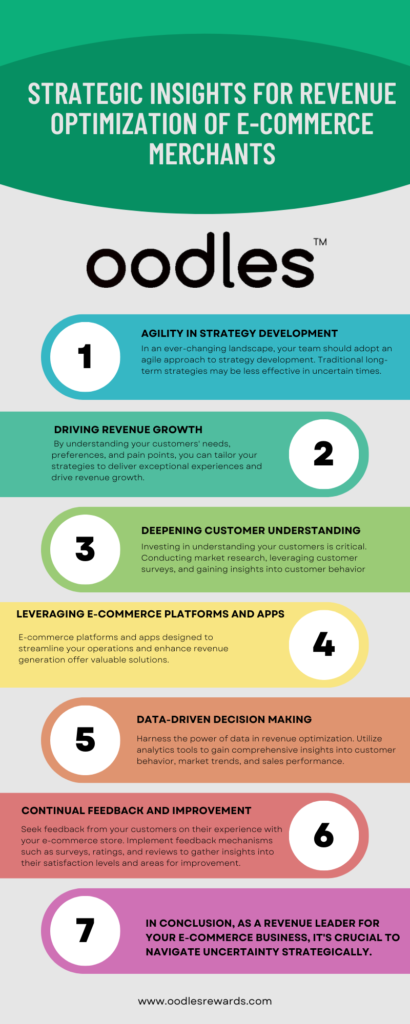Introduction: As an e-commerce merchant, you understand the challenges of operating in a landscape filled with uncertainty and the need for constant reinvention. In a year where resources such as headcount, budget, and tools may be scarcer than before, it becomes crucial for you, as a revenue leader, to make informed decisions about where to focus your efforts in improving revenue motions. This blog will explore strategic insights tailored to e-commerce merchants backed by industry data and research. Join us as we uncover the top predictions and recommend approaches for revenue teams to meet their targets in the face of uncertainty.
Embracing Agility: Adapting Strategies for Success As a revenue leader, fostering adaptability and embracing change for your e-commerce store is vital. By recognizing the need for reinvention and staying agile, you can ensure your team makes the right decisions to drive improvements and achieve revenue goals. Let’s explore critical areas to focus on:
Agility in Strategy Development
In an ever-changing landscape, your team should adopt an agile approach to strategy development. Traditional long-term strategies may be less effective in uncertain times. Instead, consider setting shorter-term goals and regularly reviewing progress. It allows you to adjust your strategies based on market conditions, customer feedback, and emerging opportunities. Your revenue team can seize opportunities and optimize revenue generation by staying agile and responsive.
To foster agility in strategy development, create a culture of flexibility and adaptability within your team. Encourage open communication and collaboration, enabling team members to share their insights, ideas, and feedback. This collaborative approach allows for a more holistic view of the market landscape. It promotes generating innovative strategies that respond effectively to changing customer needs and market dynamics.
Iterative Execution and Experimentation Adopting an iterative approach to execution is essential in uncertain times. Instead of waiting for the perfect plan, break down your initiatives into smaller, manageable steps. This approach allows you to gather real-time feedback and adjust your tactics accordingly. By embracing experimentation, you can test different approaches, learn from failures, and iterate on your strategies to optimize revenue outcomes. Embracing a culture of learning and adaptation will position your e-commerce business for success. Encourage your team to experiment with different marketing and sales tactics. It could involve A/B testing different messaging, offers, or pricing strategies to identify the most effective approaches for driving revenue.
Encourage cross-functional collaboration involving marketing and sales teams in joint initiatives. This collaboration promotes knowledge sharing and enables the identification of new revenue opportunities through creative problem-solving.
Putting Customers at the Center: Driving Revenue Growth
In uncertain times, prioritizing customer-centricity is paramount for e-commerce merchants. By understanding your customers’ needs, preferences, and pain points, you can tailor your strategies to deliver exceptional experiences and drive revenue growth. Let’s delve into customer-centric approaches:
Deepening Customer Understanding
Investing in understanding your customers is critical. Conducting market research, leveraging customer surveys, and gaining insights into customer behavior through customer data analysis are essential for understanding their preferences and needs. This understanding will enable you to align your strategies with their needs, driving increased engagement and loyalty. Utilize customer analytics tools to identify trends and patterns, segment your customer base, and personalize your marketing and sales efforts accordingly.
To truly understand your customers’ motivations and pain points, it is vital to complement customer data analysis with qualitative research methods. You can gain deep insights beyond quantitative data analysis by incorporating techniques such as interviews or focus groups. Incorporating qualitative research methods, such as interviews or focus groups, offers a valuable opportunity to delve deeper into understanding your customers’ motivations and pain points. These methods provide a rich and nuanced perspective that goes beyond the limitations of quantitative data analysis alone. Utilizing these methods can gain valuable insights beyond quantitative data analysis. Engaging directly with your customers allows you to gain unique insights that quantitative data may only capture partially. These insights will inform your strategy and enable you to create tailored experiences that resonate with your target audience.
Personalization for Enhanced Experiences
Customers expect personalized experiences, and meeting those expectations can increase revenue. Advanced technologies like AI and machine learning provide personalized recommendations, customized offers, and tailored interactions. You can create unique and relevant experiences that resonate with your target audience by leveraging customer data and behavioral insights. Personalization not only drives conversions but also fosters long-term loyalty and advocacy.
To implement effective personalization strategies, leverage the data you have gathered on your customers. Use segmentation techniques to group customers based on their preferences, purchase history, or demographic information. This segmentation allows you to create targeted marketing campaigns and personalized offers that speak directly to each segment’s needs and interests. Additionally, consider implementing dynamic content on your website or email campaigns to deliver real-time personalized experiences based on individual customer behavior. Technology is a vital tool for revenue optimization in the digital era. It enables e-commerce merchants to streamline operations, make data-driven decisions, and deliver exceptional customer experiences.
Revenue optimization for e-commerce merchants Identifying and leveraging the right tools and platforms can streamline processes, automate tasks, and enhance efficiency.
Let’s explore key areas where technology can make a significant impact:
Leveraging E-commerce Platforms and Apps
E-commerce platforms and apps designed to streamline your operations and enhance revenue generation offer valuable solutions. Explore apps that provide AI-powered chatbots for customer support, loyalty and rewards programs for driving repeat purchases, and omnichannel integration for seamless customer interactions across platforms like WhatsApp, Instagram, and Facebook Messenger. These tools can help you automate processes, improve customer experiences, and increase conversions.
Consider integrating AI-powered chatbots into your e-commerce store to provide round-the-clock customer support. These chatbots can answer frequently asked questions, assist customers in making purchase decisions, and provide personalized recommendations. Furthermore, explore loyalty and rewards programs that incentivize repeat purchases and encourage customer retention. These programs can track and reward customer loyalty, fostering long-term relationships.

Data-Driven Decision Making
Harness the power of data in revenue optimization. Utilize analytics tools to gain comprehensive insights into customer behavior, market trends, and sales performance. By leveraging these insights, you can make informed decisions, allocate resources effectively, and focus on revenue-generating activities with the highest potential. Monitor key performance indicators (KPIs) and use data visualization tools to track progress and identify areas for improvement. Data-driven decision-making empowers you to optimize your revenue strategies and stay ahead of the competition.
Invest in robust analytics tools that provide comprehensive reporting and analysis capabilities. These tools can help you track and measure critical metrics like conversion rates, customer lifetime value, and average order value. Analyze data on customer behavior, such as website interactions, purchase history, and demographic information, to identify patterns and trends. Use this data to make data-driven decisions, optimize marketing campaigns, and allocate resources strategically.
Nurturing Customer Relationships for Long-Term Success Building strong customer relationships is crucial for sustained revenue growth. By prioritizing customer satisfaction and retention, you can create a loyal customer base that drives repeat purchases and advocacy. Let’s explore strategies for nurturing customer relationships: Exceeding customer expectations with exceptional service is crucial in a competitive e-commerce landscape. Train your customer service team to deliver personalized and timely support, resolving customer queries and issues efficiently. Implement self-service options, such as comprehensive FAQ sections and knowledge bases, to empower customers to find answers independently. You can foster loyalty and positive word-of-mouth by exceeding customer expectations in terms of service.
Proactive Customer Engagement Engaging with your customers proactively demonstrates your commitment to their satisfaction—leverage automation tools to send personalized email campaigns, relevant product recommendations, and follow-up messages after purchases. Implement loyalty and rewards programs that incentivize engagement and provide exclusive benefits to your most loyal customers. You can foster long-term relationships that drive revenue growth by nurturing a sense of belonging and appreciation.
Continual Feedback and Improvement
Seek feedback from your customers on their experience with your e-commerce store. Implement feedback mechanisms such as surveys, ratings, and reviews to gather insights into their satisfaction levels and areas for improvement. Pay close attention to customer feedback and adapt your processes accordingly. By continually improving based on customer feedback, you can enhance their experience, build trust, and drive revenue growth.
Conclusion:
E-commerce merchants face unique hurdles in driving revenue growth in a year that presents challenges and uncertainty. By embracing agility, putting customers at the center of your strategies, and harnessing the power of technology, you can position your business for resilience and growth. Stay informed about industry trends, seek expert guidance, and continuously refine your approach to revenue generation.
As a merchant, you can leverage the tools and resources to drive success in an ever-changing landscape. Oodles, an all-in-one app designed specifically for e-commerce merchants, offers a comprehensive solution that includes AI chatbot capabilities, loyalty and rewards programs, SMS marketing features, and seamless omnichannel integration. By incorporating Oodles into your revenue strategies, you can further enhance customer engagement, drive conversions, and unlock the maximum potential of your online store.
In conclusion, as a revenue leader for your e-commerce business, it’s crucial to navigate uncertainty strategically. By embracing agility, prioritizing customer-centricity, and harnessing the power of technology, you can optimize your revenue motions, drive growth, and thrive in the ever-evolving e-commerce landscape.

